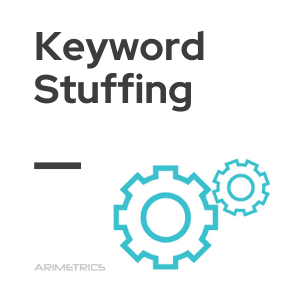
Definition:
Keyword stuffing is an SEO over-optimization technique resulting from an excessive use of keywords in a content. It is based on the repeated and conscientious repetition of a keyword in a text. It is a negative technique since beyond seeking positioning easily and effortlessly, it does not provide anything of value for the user, considerably reducing the quality of the texts and robotizing them. Originally, this and other Black Hat SEO techniques were very effective when it came to organically positioning a web page.
However, Google, in its attempt to improve the quality of its search engine and the value it brings to its users, has been introducing successive updates such as Google Panda or Google Penguin , which detect this type of behavior as negative for the user, penalizing them and lowering positions on the rank page. A text is susceptible to keyword stuffing when a very high keyword density is detected in it, but it should be noted that if this occurs because the nature of the text itself demands it, Google will not penalize the web page.
How to solve keyword stuffing
If your website had any of the practices mentioned above and you have noticed a considerable drop in page rank, it is very likely that Google has penalizedy ou. To correct the penalties for keyword stuffing it is necessary to review these texts and rewrite them in a much more natural and dynamic way, which adds value to users and is relevant depending on the search they have made. Reducing the number of times the keyword appears is essential, for this we can also choose to use synonyms in semantic constructions. In case we need help, there are several applications that perform semantic analysis and SEO in general, free of charge.
Consequences of keyword stuffing
Excessive use of keywords not only affects the quality of the content, but can also have significant repercussions on the visibility and reputation of a web page.
Some of the most common consequences include:
- Google penalties: As mentioned, algorithm updates such as Google Panda and Google Penguin are designed to identify and penalize black hat SEO techniques, including keyword stuffing.
This can result in a drastic drop in search ranking, which limits page visibility. - Deteriorated user experience: Content that is cluttered with keywords becomes difficult to read and unattractive to users.
This can lead to a high bounce rate, where visitors leave the site quickly, which in turn can negatively affect the SEO performance of the page. - Damage to brand credibility: If users perceive that a brand is using misleading techniques to attract traffic, this can damage its reputation.
Consumer trust is critical, and keyword stuffing can cause users to doubt the authenticity and quality of the content offered.
Best practices for effective SEO optimization
To avoid keyword stuffing and improve SEO effectively, it is essential to follow certain best practices to ensure content quality and relevance to the user.
Some of these practices include:
- Moderate use of keywords: Instead of repeating a keyword several times, it is advisable to use it in a natural way and in relevant contexts.
A keyword density between 1% and 2% is usually considered optimal. - Focus on quality content: Prioritizing the creation of valuable and useful content for users is key.
This involves offering relevant, well-structured and easy-to-read information, which not only improves the user experience, but can also attract quality backlinks. - Incorporation of variants and synonyms: Using synonyms and related terms in the content not only helps to avoid keyword stuffing, but also improves the semantics of the text.
This allows search engines to better understand the context of the content and its relevance to users’ searches.
